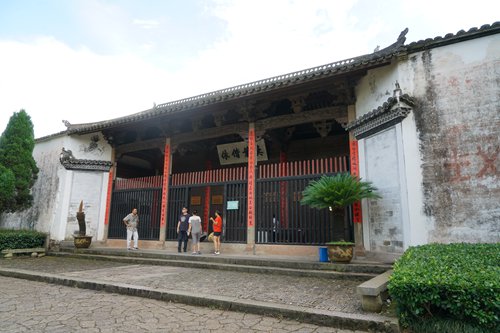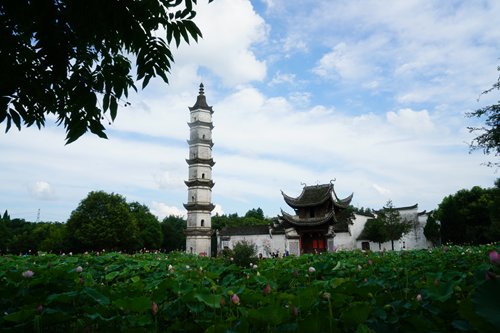
Promotion photos for the documentary TV series Chinese Villages (Photo/Courtesy of Zhejiang Radio & TV Group)

Promotion photos for the documentary TV series Chinese Villages (Photo/Courtesy of Zhejiang Radio & TV Group)
The urbanization of China's rural areas is taking place at a stunning rate. In 2000, China had 3.6 million villages, while by 2010 that figure had dropped to 2.7 million, a loss of roughly 900,000 villages over a decade.
This rapid urbanization has led to an influx of people calling for rural village protection and revitalization. Among them are local government officials, artists, businessmen and even foreigners.
The landscape of rural China and its struggles with urbanization is exactly what director Xia Yanping wanted to cover in his documentary TV series Chinese Villages. Co-produced by Zhejiang Radio & TV Group and the China Academy of Art, the eight-episode documentary TV series aims to reveal the beauty of around 30 little-known Chinese villages.
Still in the production phase, Xia and his team have visited a handful of villages over the last couple of months. These include renowned villages such as Wuzhen in East China's Zhejiang Province, Hongcun in East China's Anhui Province, as well as some lesser-known remote villages in the Ganzi Tibetan Autonomous Prefecture in Southwest China's Sichuan Province and the Inner Mongolia Autonomous Region.
However, a large number of these villages have either already disappeared by now or are about to be wiped from the map, Xia told the Global Times on December 4.
A fine line
The crew has planned to visit renowned villages such as Wuzhen in East China's Zhejiang Province, Hongcun in Anhui Province as well as some remote villages in the Garzê Tibetan Autonomous Prefecture in Southwest China's Sichuan Province.
In the final episode of the series, titled Recreation, the team will showcase the struggles that Chinese villages face today and display the various approaches people have taken to protect and develop them.
Some villages have become homestays or hotels; some villages have kept modernization at bay in order to hold on to what makes it special; others are being strategically developed in the hopes of drawing people back; artists have also been carrying out their own pilot programs in villages, according to Xia.
While projects have met with various levels of success, village preservation is not without its controversies.
At present, tourism is the most common way to try and breathe new life into a rural village. However, this also runs the risk of falling into the pitfalls of overdevelopment and rampant commercialization, which can result in a village whose original residents have been pushed out as it becomes filled with nothing but shops and outsiders who have flocked there to sell souvenirs.
Although tourism development and commercialization can be a tricky path to walk, most places wouldn't be able to survive at all otherwise.
"I always have mixed feelings walking into some rural house that has been turned into a homestay. They look traditional on the outside but the inside has been hollowed out. However if it hadn't been turned into a homestay, it probably wouldn't exist at all," Xia said.
Rebuilding a foundation
Rapid urbanization also risks erasing the rural culture, traditions and history upon which much of Chinese civilization was founded.
"Chinese culture has traditionally been rural-based," said Tong Chaosu, head of the Society for the Promotion of Zhejiang Folk Culture. "Rescuing ancient villages means rescuing our cultural heritage. I think the core value of ancient village farming culture lies in the relationships between people, people and nature, and a person and their own mind. You can find this trio of relationships in rural villages."
It is certainly true that China's rural areas are a treasure trove of tradition. Of the country's roughly 9,700 examples of national-level intangible cultural heritage, about 80 percent of them are found in rural areas.
Having researched folk culture for years, Tong said what she feared most was the copy-and-paste nature of the many "ancient" water towns popping up around the country. They all seem to feature the same houses facing lakes, overhangs lined with red lanterns and boats floating on rivers.
"There is no culture once something becomes a formula," Tong said.
Another dilemma facing villages is that young people are no longer willing to live in dark, wet houses while others move into modern apartments.
After visiting these villages, Xia found that many problems, such as modern accommodations, could have been solved while also preserving the villages. "But now they have been replaced with tracks of ugly new houses, which moved us to tears," Xia said.
The documentary will use three-dimensional models to restore villages and reveal what they once looked like before being torn down.
"Through this display of beautiful rural life and nostalgia, we hope to get people thinking about what we have lost and how to protect Chinese villages, he added.
Family lines
While the documentary will focus quiet a lot on the infrastructure of villages, it has not forgotten about the people who live in these houses.
The episodes Family Biography and Prominent Families will focus on the relationships between villages and families.
Living in Zhengzhai town, Zhejiang Province, for centuries, the Zheng family have adhered to the rules and standards passed down in their family for generations. Over a period of 800 years, many members of the family held high-level positions in imperial courts, earning the family a reputation for decency and honesty.
The villagers who live nearby the Qiao Family Compound in North China's Shanxi Province, famous for being the chief location in the Zhang Yimou film Raise the Red Lantern, are still known for being honest businessmen, an identity founded by their ancestors more than 600 years ago.


















































